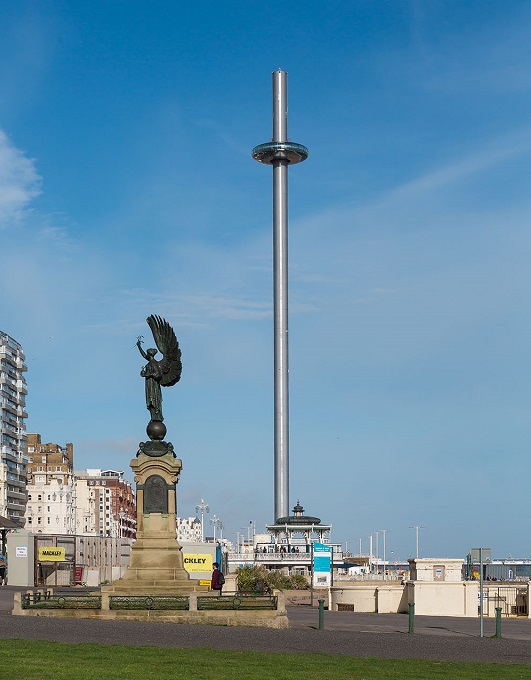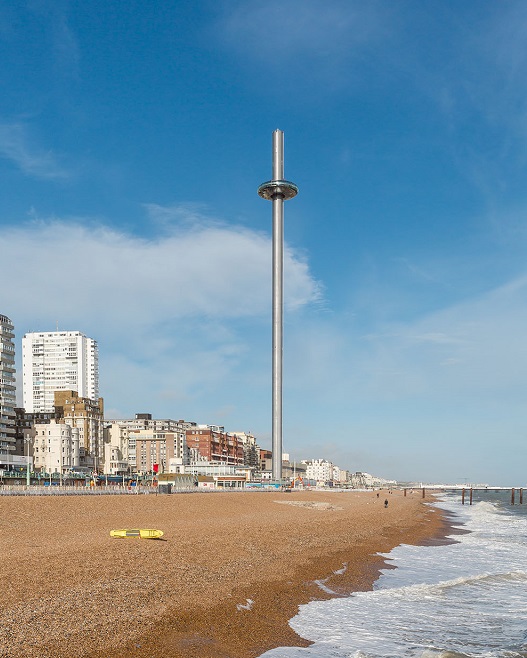British Airways i360 observation tower
On 4 August 2016, British Airways i360, the world’s tallest moving observation tower, opened to the public. Located on Brighton beach, developers hope the tower transforms the town's tourism prospects.
British Airways i360 was conceived and designed by Marks Barfield Architects, creators of the London Eye. The pod has been designed and built by cable car specialists POMA, who built the capsules for the London Eye. At 18 m (59ft) wide, the viewing pod is 10 times bigger than a capsule on the London Eye.
The overall height of the tower is 162 m, with an observation pod that rises from ground level to 138 m, offering 360-degree views of Brighton and Hove, the Sussex coast and the English Channel. It also holds the Guinness World Record for the most slender tower in the world, with its widest point being just 3.9 m.
Movement tests on the pod began earlier in June, progressing to a height of 30 m before reaching its full height on the 14th June.
The curved-glass pod is capable of carrying up to 200 visitors per ‘flight’, which lasts a total of 20 minutes (30 in the evening). The concept of the tower is that it will serve as a ‘vertical pier’, sited as it is at the root end of Brighton’s historic West Pier which closed in 1975 and remains in ruins following a fire in 2003.
The tower has its detractors though, with some describing it as an 'eyesore' which 'ruins the sea views' of Brighton.
The attraction’s visitor centre will incorporate a 400-seat restaurant The Belle Vue Brighton, a gift shop, a children’s play zone, an exhibition space, and conference and event facilities.
For more information, please see British Airways i360.
Content and images: British Airways i360 ‘The British Airways i360 pod reaches its maximum height of 138m for the first time.’
[edit] Related articles on Designing Buildings Wiki
Featured articles and news
Gregor Harvie argues that AI is state-sanctioned theft of IP.
Heat pumps, vehicle chargers and heating appliances must be sold with smart functionality.
Experimental AI housing target help for councils
Experimental AI could help councils meet housing targets by digitising records.
New-style degrees set for reformed ARB accreditation
Following the ARB Tomorrow's Architects competency outcomes for Architects.
BSRIA Occupant Wellbeing survey BOW
Occupant satisfaction and wellbeing tool inc. physical environment, indoor facilities, functionality and accessibility.
Preserving, waterproofing and decorating buildings.
Many resources for visitors aswell as new features for members.
Using technology to empower communities
The Community data platform; capturing the DNA of a place and fostering participation, for better design.
Heat pump and wind turbine sound calculations for PDRs
MCS publish updated sound calculation standards for permitted development installations.
Homes England creates largest housing-led site in the North
Successful, 34 hectare land acquisition with the residential allocation now completed.
Scottish apprenticeship training proposals
General support although better accountability and transparency is sought.
The history of building regulations
A story of belated action in response to crisis.
Moisture, fire safety and emerging trends in living walls
How wet is your wall?
Current policy explained and newly published consultation by the UK and Welsh Governments.
British architecture 1919–39. Book review.
Conservation of listed prefabs in Moseley.
Energy industry calls for urgent reform.



























Comments
What an eye sore!